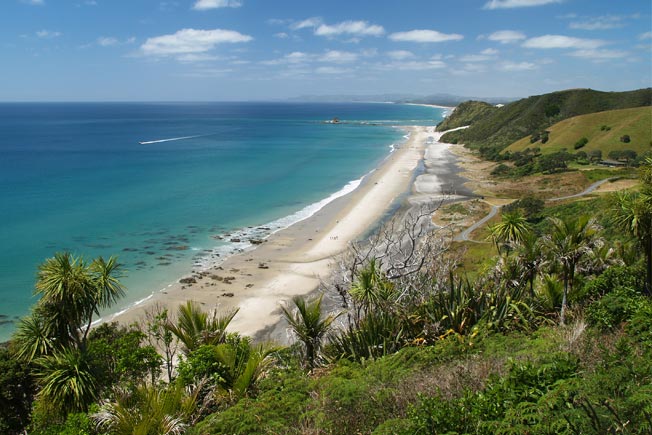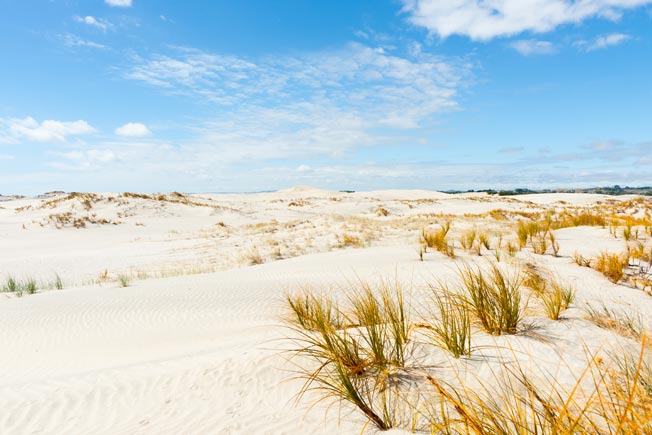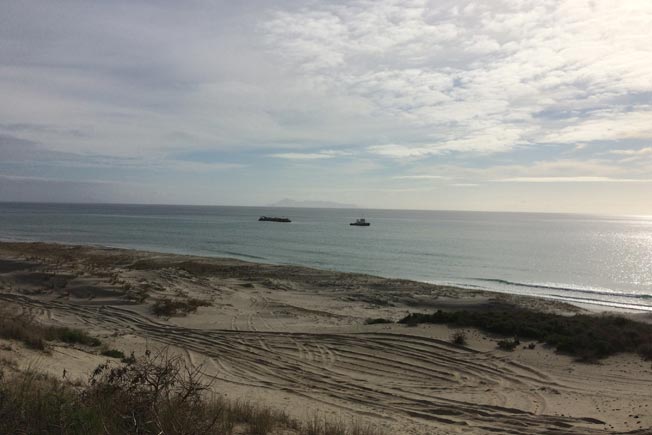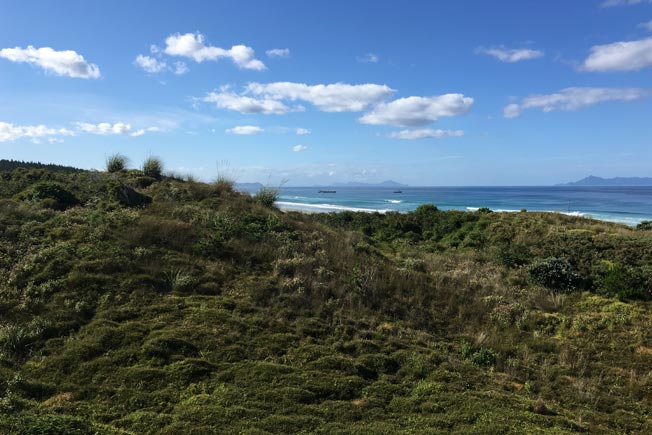It’s one of our most widely used natural resources, but it’s scarcer than you think.
The final event of last year’s beach-volleyball world tour was held in Toronto, in September, in a parking lot at the edge of Lake Ontario. There’s a broad public beach nearby, but few actual beaches meet the Fédération Internationale de Volleyball’s strict standards for sand, so the tournament’s sponsor had erected a temporary stadium and imported thirteen hundred and sixty tons from a quarry two and a half hours to the north. The shipment arrived in thirty-five tractor-trailer loads.
I visited the site shortly before the tournament, and spoke with Todd Knapton, who was supervising the installation. He’s the vice-president of the company that supplied the sand, Hutcheson Sand & Mixes, in Huntsville, Ontario. He’s in his fifties, and he was wearing a white hard hat, a neon-yellow-green T-shirt, dark-gray shorts, and slip-on steel-toed boots. We walked through a gate and across an expanse of asphalt to a pair of warmup courts, which from a distance looked like enormous baking pans filled with butterscotch-brownie batter. “You want to see the players buried up to their ankles,” he said, and stuck in a foot, to demonstrate. “Rain or shine, hot or cold, it should be like a kid trying to ride a bicycle through marbles.”
Ordinary beach sand tends to be too firm for volleyball: when players dive into it, they break fingers, tear hamstrings, and suffer other impact injuries. Knapton helped devise the sport’s sand specifications, after Canadian players complained about the courts at the 1996 Olympic Games, in Atlanta. “It was trial and error at first,” he said. “But we came up with an improved recipe, and we now have a material that’s uniform from country to country to country, on five continents.” The specifications govern the shape, size, and hardness of the sand grains, and they disallow silt, clay, dirt, and other fine particles, which not only stick to perspiring players but also fill voids between larger grains, making the playing surface firmer. The result is sand that drains so well that building castles with it would be impossible. “We had two rainstorms last night, but these courts are ready to play on,” he said. “You could take a fire hose to this sand and you’d never flood it.”
Beach-volleyball promoters all over the world have to submit one-kilogram samples to Knapton for approval, and his office now contains hundreds of specimens. (He also vets beach-soccer sand for fifa.) Hutcheson doesn’t ship its own sand to events overseas, but Knapton and his colleagues often create courts in other countries, after sourcing sand where they can. He took off his hard hat and showed me the underside of the brim, on which he had recorded, in black Sharpie, the names and dates of big events they’ve handled, among them the Olympic Games in Sydney, Athens, Beijing, and London. (The sand for London came from Redhill, in Surrey; the sand for Athens came from Belgium.) The company’s biggest recent challenge was the first European Games, which were held in Baku, Azerbaijan, in 2015. Baku has beaches—it’s on a peninsula on the western shore of the Caspian Sea—but the sand is barely suitable for sunbathing, much less for volleyball. Knapton’s crew searched the region and found a large deposit with the ideal mixture of particle sizes, in a family-owned mine in the Nur Mountains, in southern Turkey, eight hundred miles to the west.
The mine is within shelling distance of the Syrian border. Knapton had planned to transport the sand across central Syria, through Iraq, around Armenia, and into Azerbaijan from the northwest, in two convoys of more than two hundred and fifty trucks each. But geopolitics intervened. “You can cross those borders only at certain hours of the day, and isis was making the guys antsy,” he said. “In the end, we said, ‘Well, we could have handled one war.’ ” Instead, Knapton and his crew bagged the sand in one-and-a-half-ton fabric totes, trucked it west to Iskenderun, and craned it onto ships. “We did five vessels, five separate trips,” Knapton said. “The route went across the Mediterranean, up the Aegean, through the Bosporus, across the Black Sea, and into Sochi.” From there, they took the sand by rail through Russia and Georgia, around Armenia, and across Azerbaijan. “The Syrian exodus was on at that time, and we saw people walking for their lives,” he said. “But these were the first-ever European Games, so everything had to be right.”
Sand covers so much of the earth’s surface that shipping it across borders—even uncontested ones—seems extreme. But sand isn’t just sand, it turns out. In the industrial world, it’s “aggregate,” a category that includes gravel, crushed stone, and various recycled materials. Natural aggregate is the world’s second most heavily exploited natural resource, after water, and for many uses the right kind is scarce or inaccessible. In 2014, the United Nations Environment Programme published a report titled “Sand, Rarer Than One Thinks,” which concluded that the mining of sand and gravel “greatly exceeds natural renewal rates” and that “the amount being mined is increasing exponentially, mainly as a result of rapid economic growth in Asia.”
Pascal Peduzzi, a Swiss scientist and the director of one of the U.N.’s environmental groups, told the BBC last May that China’s swift development had consumed more sand in the previous four years than the United States used in the past century. In India, commercially useful sand is now so scarce that markets for it are dominated by “sand mafias”—criminal enterprises that sell material taken illegally from rivers and other sources, sometimes killing to safeguard their deposits. In the United States, the fastest-growing uses include the fortification of shorelines eroded by rising sea levels and more and more powerful ocean storms—efforts that, like many attempts to address environmental challenges, create environmental challenges of their own.
Geologists define sand not by composition but by size, as grains between 0.0625 and two millimetres across. Just below sand on the size scale is silt; just above it is gravel. Most sand consists chiefly of quartz, the commonest form of silica, but there are other kinds. Sand on ocean beaches usually includes a high proportion of shell pieces and, increasingly, bits of decomposing plastic trash; Hawaii’s famous black sand is weathered fragments of volcanic glass; the sand in the dunes at White Sands National Monument, in New Mexico, is mainly gypsum. Sand is almost always formed through the gradual disintegration of bigger rocks, by the action of ice, water, wind, and time, but, as the geologist Michael Welland writes, in his book “Sand: The Never-Ending Story,” many of those bigger rocks were themselves formed from accumulations of the eroded bits of other rocks, and “perhaps half of all sand grains have been through six cycles in the mill, liberated, buried, exposed, and liberated again.”
Sand is also classified by shape, in configurations that range from oblong and sharply angular to nearly spherical and smooth. Desert sand is almost always highly rounded, because strong winds knock the grains together so forcefully that protrusions and sharp edges break off. River sand is more angular. William H. Langer, a research geologist who retired from the U.S. Geological Survey a few years ago and now works as a private consultant, told me, “In a stream, there’s a tiny film of water around each grain, so when the grains bang together there’s enough energy to break them apart but not enough to let them rub against each other.” The shape of sand deposited by glaciers and ice sheets depends partly on how far the sand was moved and what it was moved over. Most of the sand in the Hutcheson quarry is “sub-angular”: the grains have fractured faces, but the sharp edges have been partly abraded away. Sand that’s very slightly more smooth-edged is “sub-rounded.”
Aggregate is the main constituent of concrete (eighty per cent) and asphalt (ninety-four per cent), and it’s also the primary base material that concrete and asphalt are placed on during the building of roads, buildings, parking lots, runways, and many other structures. A report published in 2004 by the American Geological Institute said that a typical American house requires more than a hundred tons of sand, gravel, and crushed stone for the foundation, basement, garage, and driveway, and more than two hundred tons if you include its share of the street that runs in front of it. A mile-long section of a single lane of an American interstate highway requires thirty-eight thousand tons. The most dramatic global increase in aggregate consumption is occurring in parts of the world where people who build roads are trying to keep pace with people who buy cars. Chinese officials have said that by 2030 they hope to have completed a hundred and sixty-five thousand miles of roads—a national network nearly three and a half times as long as the American interstate system.
Windowpanes, wineglasses, and cell-phone screens are made from melted sand. Sand is used for filtration in water-treatment facilities, septic systems, and swimming pools. Oil and gas drillers inject large quantities of hard, round sand into fracked rock formations in order to hold the cracks open, like shoving a foot in the door. Railroad locomotives drop angular sand onto the rails in front of their wheels as they brake, to improve traction. Australia and India are major exporters of garnet sand, which is crushed to make an abrasive material used in sandblasting and by water-jet cutters. Foundries use sand to form the molds for iron bolts, manhole covers, engine blocks, and other cast-metal objects. I once visited a foundry in Arizona whose products included parts for airplanes, cruise missiles, and artificial hip joints, and I watched a worker pouring molten stainless steel into a mold that had been made by repeatedly dipping a wax pattern into a ceramic slurry and then into sand. The work area was so hot that I nervously checked my arm, because I thought my shirt was on fire. Factories that produce plate glass—by pouring thin layers of molten silica onto baths of molten tin—can be hotter.
In some applications, natural aggregate can be replaced by or supplemented with recycled materials, but the possibilities are limited. And efforts to reduce consumption are complicated by the fact that many environmentally desirable products and activities depend as heavily on aggregate as environmentally undesirable ones do: solar panels are made from silica and silicon; wind turbines are manufactured with foundry sand; autonomous electric vehicles need roads and highways, too.
ast summer, at a quarry in western Connecticut, I put my hand into a big pile of sand that was the pinkish-gray color of calamine lotion. In a couple of months, the pile was going to be trucked to New York City, eighty miles south, and spread on top of Wollman Rink for the annual Rolex Central Park Horse Show. (Afterward, the sand would be trucked back to the quarry, to be stored until the following fall.) Bill Stanley, a vice-president of the construction company that owns the quarry, told me, “We make a customized, proprietary blend of horse-footing sand, and we’re sending it all over New York State and out to the Rocky Mountains. People want it in Europe, too.” The color comes from a dye; fibres and other additives are mixed in as well, to create a material that is sufficiently yielding to protect the feet and legs of very large animals but firm enough to support running and jumping. (It’s too stiff for volleyball.)
There’s no single standard for equestrian sand; different producers have different recipes. The pile I stuck my hand into is known as a manufactured sand, because it was produced by crushing stone—in this case, dolomitic marble. The marble in the quarry is part of the Stockbridge Formation, which runs from eastern New York to Vermont. “You can’t really use it as building marble, because it’s too jointed,” Stanley said. “But it makes exceptionally high-quality sand. It’s all calcium carbonate and magnesium carbonate, and Portland cement chemically bonds with it. We sell it mostly for landscaping and for architectural concrete.” He drove me up a narrow access road to a spot overlooking the main pit. “We developed this quarry for sand,” he said. “Sand is something you’ve got to keep your eye on, to be sure you have a good, reliable source for the long term.” For many years, Stanley’s company bought large quantities of high-quality aggregate from a dredging operation off the southern end of Staten Island, not far from an entrance to New York Harbor, but that operation was shut down in 2015, amid concerns that the dredges were doing environmental damage to the seafloor.
One engineer I spoke to told me that transporting sand and stone for ordinary construction becomes uneconomical after about sixty miles, and that builders usually make do with whatever is available within that radius, even if it means settling for materials that aren’t ideal. In some places, though, there are no usable alternatives. Florida lies on top of a vast limestone formation, but most of the stone is too soft to be used in construction. “The whole Gulf Coast is starved for aggregate,” William Langer, the research geologist, told me. “So they import limestone from Mexico, from a quarry in the Yucatán, and haul it by freighter across the Caribbean.” Even that stone is wrong for some uses. “You can build most of a road with limestone from Mexico,” he continued, “but it doesn’t have much skid resistance. So to get that they have to use granitic rock, which they ship down the East Coast from quarries in Nova Scotia or haul by train from places like inland Georgia.” When Denver International Airport was being built, in the nineteen-nineties, local quarries were unable to supply crushed stone as rapidly as it was needed, so vast quantities were brought from a quarry in Wyoming whose principal product was stone ballast for railroad tracks. The crushed stone was delivered by a freight train that ran in a continuous loop between the quarry and the work site.
Source: The New Worker Magazine













